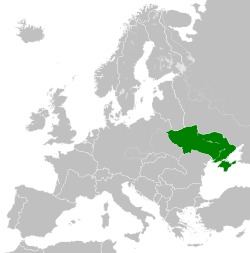
Back الإدارة العسكرية في أوكرانيا Arabic Ukrayna Reyxkomissarlığı Azerbaijani Рэйхскамісарыят Украіна Byelorussian Райхскамісарыят Украіна BE-X-OLD Reichskommissariat Ukraine Breton Reichskommissariat Ukraine Catalan Říšský komisariát Ukrajina Czech Reichskommissariat Ukraine Danish Reichskommissariat Ukraine German Reichskommissariat Ukraine Spanish
Reichskommissariat Ukraine | |||||||||||
|---|---|---|---|---|---|---|---|---|---|---|---|
| 1941–1944 | |||||||||||
| Anthem: Horst-Wessel-Lied ("The Horst Wessel Song") | |||||||||||
 Reichskommissariat Ukraine in 1942 | |||||||||||
| Status | Reichskommissariat of Nazi Germany | ||||||||||
| Capital | Kiev (de jure) Rovno (de facto) | ||||||||||
| Common languages | German (official) | ||||||||||
| Government | Reichskommissariat of Nazi Germany[1] | ||||||||||
| Reichskommissar | |||||||||||
• 1941–1944 | Erich Koch | ||||||||||
| Historical era | World War II | ||||||||||
| 22 June 1941 | |||||||||||
• Established | 20 August 1941 | ||||||||||
• Implement civil administration | 1 September 1941 | ||||||||||
• Remainder part of Generalbezirk Weißruthenien | 25 February 1944 | ||||||||||
• Formal disestablishment | 10 November 1944 | ||||||||||
| Area | |||||||||||
• Total | 340,000 km2 (130,000 sq mi) | ||||||||||
| Population | |||||||||||
• 1941 | 37,000,000 | ||||||||||
| Currency | Karbovanets | ||||||||||
| |||||||||||
| Today part of | |||||||||||
| History of Ukraine |
|---|
 |
The Reichskommissariat Ukraine (RKU; lit. 'Reich Commissariat of Ukraine') was established by Nazi Germany in 1941 during World War II. It was the civilian occupation regime of much of German-occupied Ukraine (it also included adjacent areas of the Byelorussian SSR, Russian SFSR, and pre-war Poland). It was governed by the Reich Ministry for the Occupied Eastern Territories headed by Alfred Rosenberg. Between September 1941 and August 1944, the Reichskommissariat was administered by Erich Koch as the Reichskommissar. The administration's tasks included the pacification of the region and the exploitation, for German benefit, of its resources and people. Adolf Hitler issued a Führer decree defining the administration of the newly-occupied Eastern territories on 17 July 1941.[2]
Before the German invasion, Ukraine was a constituent republic of the Soviet Union, inhabited by Ukrainians, Russians, Jewish, Belarusian, Romanian, Polish, and Roma/Gypsy minorities. It was a key subject of Nazi planning for the post-war expansion of the German state. The Nazi extermination policy in Ukraine, with the help of local Ukrainian collaborators,[3] ended the lives of millions of civilians in The Holocaust and other Nazi mass killings: it is estimated 900,000 to 1.6 million Jews and 3[4] to 4[5] million non-Jewish Ukrainians were killed during the occupation; other sources estimate that 5.2 million Ukrainian civilians (of all ethnic groups) perished due to crimes against humanity, war-related disease, and famine amounting to more than 12% of Ukraine's population at the time.[6]
- ^ "Reichskommissariat Ukraine". www.encyclopediaofukraine.com. Retrieved 2020-03-03.
A German colony, the RKU constituted an important part of Adolf Hitler's Lebensraum and was completely deprived of autonomy or international status. Nazi plans called for the postwar unification of the RKU with the territory of the German Reich; most Ukrainians (considered unfit for Germanization) were to be resettled beyond the Urals to make room for German colonists. In fact Hitler was unable to inspire many Germans to colonize Ukraine. Despite ambitious plans only a few villages were cleared of their Ukrainian inhabitants and populated with Germans (both groups were resettled under duress). Those experiments were profoundly resented by the local population, which saw them as portents of German postwar intentions. Resettlement was also prevented by the German retreat and then by the formal liquidation of the RKU on 10 November 1944.
- ^ "Nazi Conspiracy and Aggression". Decree of the Fuehrer concerning the administration of the newly-occupied Eastern territories. The Avalon Project at Yale Law School. 1996–2007. Retrieved 2007-10-04.
- ^ Alfred J. Rieber (2003). "Civil Wars in the Soviet Union" (PDF). pp. 133, 145–147. Archived from the original (PDF) on 2020-10-30. Retrieved 2022-06-20. Slavica Publishers.
- ^ Magocsi, Paul Robert (1996). A History of Ukraine. University of Toronto Press. p. 633. ISBN 9780802078209.
- ^ Michael Berenbaum (ed.), A Mosaic of Victims: Non-Jews Persecuted and Murdered by the Nazis, New York University Press, 1990; ISBN 1-85043-251-1
- ^ Vadim Erlikman. Poteri narodonaseleniia v XX veke: spravochnik. Moscow, 2004. ISBN 5-93165-107-1. pp. 21–35.

